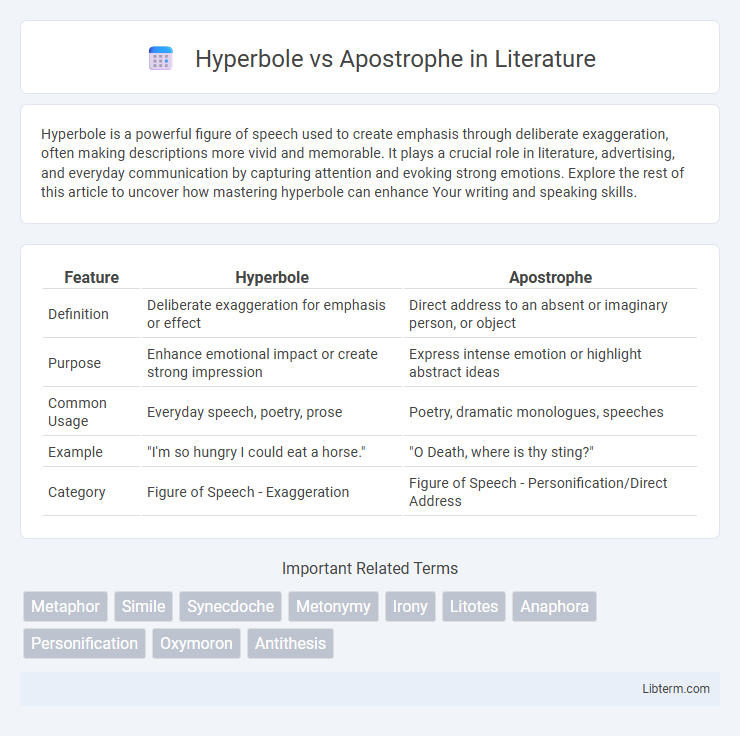Hyperbole is a powerful figure of speech used to create emphasis through deliberate exaggeration, often making descriptions more vivid and memorable. It plays a crucial role in literature, advertising, and everyday communication by capturing attention and evoking strong emotions. Explore the rest of this article to uncover how mastering hyperbole can enhance Your writing and speaking skills.
Table of Comparison
| Feature | Hyperbole | Apostrophe |
|---|---|---|
| Definition | Deliberate exaggeration for emphasis or effect | Direct address to an absent or imaginary person, or object |
| Purpose | Enhance emotional impact or create strong impression | Express intense emotion or highlight abstract ideas |
| Common Usage | Everyday speech, poetry, prose | Poetry, dramatic monologues, speeches |
| Example | "I'm so hungry I could eat a horse." | "O Death, where is thy sting?" |
| Category | Figure of Speech - Exaggeration | Figure of Speech - Personification/Direct Address |
Understanding Hyperbole: Definition and Purpose
Hyperbole is a deliberate exaggeration used to emphasize a point or evoke strong feelings, often stretching reality for dramatic effect. Its primary purpose is to create emphasis or highlight intensity in descriptions, making ideas more memorable and impactful. Unlike literal statements, hyperbole enhances storytelling by amplifying emotions and perceptions beyond the ordinary.
Exploring Apostrophe: Meaning and Usage
Apostrophe is a rhetorical device that involves directly addressing an absent person, imaginary character, or abstract idea as if it were capable of responding. This figure of speech is commonly used in poetry and drama to convey strong emotions or create a dramatic effect by personifying non-human entities or concepts. Unlike hyperbole, which relies on exaggerated statements to emphasize a point, apostrophe engages the audience by invoking a direct and often emotional dialogue with the invoked subject.
Key Differences Between Hyperbole and Apostrophe
Hyperbole is a figure of speech that involves deliberate exaggeration to create emphasis or effect, whereas apostrophe is a rhetorical device where a speaker directly addresses an absent, imaginary, or personified entity. Hyperbole relies on overstated descriptions to evoke strong feelings or highlight a point, while apostrophe breaks the narrative flow by engaging an unrelated or non-present character. The key difference lies in hyperbole's focus on intensity of expression and apostrophe's function as a direct, often emotional or dramatic, address to an abstract idea or separate entity.
Common Examples of Hyperbole in Literature
Common examples of hyperbole in literature include phrases like "I'm so hungry I could eat a horse" from everyday speech and Shakespeare's "All the perfumes of Arabia will not sweeten this little hand" in Macbeth. Hyperboles exaggerate emotions or situations to create a strong impact, such as in Mark Twain's "The Adventures of Huckleberry Finn," where Huck describes the Mississippi River as "a mighty big river." These exaggerated expressions contrast with apostrophe, which involves directly addressing an absent or abstract entity, like in John Donne's poem "Death, be not proud," where Death is personified and spoken to directly.
Notable Uses of Apostrophe in Writing
Apostrophe, a rhetorical device where a speaker addresses an absent person, abstract idea, or inanimate object, is notably used in Shakespeare's "Macbeth" when Macbeth speaks to the dagger, saying, "Is this a dagger which I see before me?" This use of apostrophe intensifies the psychological turmoil by personifying the hallucinated vision. Such notable examples highlight its power to evoke emotion and create a direct connection between the speaker and the intangible element addressed.
The Impact of Hyperbole on Reader Perception
Hyperbole, an exaggerated statement not meant to be taken literally, intensifies emotions and emphasizes key themes, making the reader engage more deeply with the text. This rhetorical device amplifies feelings such as excitement, anger, or urgency, influencing perception by creating memorable and vivid imagery. In contrast, apostrophe directly addresses an absent or imaginary person or abstraction, fostering intimacy and emotional connection, but it does not rely on exaggeration to shape reader experience.
How Apostrophe Enhances Emotional Expression
Apostrophe enhances emotional expression by directly addressing absent or abstract entities, creating an intimate and immediate connection between the speaker and the subject. Unlike hyperbole, which relies on exaggerated statements to convey intensity, apostrophe personifies emotions, making feelings more vivid and palpable. This rhetorical device deepens the audience's emotional engagement by invoking a sense of presence and urgency toward the addressed figure or concept.
Hyperbole vs Apostrophe: When to Use Each
Hyperbole is a deliberate exaggeration used to emphasize a point or evoke strong feelings, ideal for adding dramatic effect or humor in both literature and everyday speech. Apostrophe directly addresses an absent or imaginary person, deity, or abstract idea, making it effective for expressing emotional intensity or invoking contemplation in poetry and speeches. Use hyperbole to amplify emotions or descriptions, while apostrophe works best when you want to create a personal connection with an intangible or absent entity.
Mistakes to Avoid: Confusing Hyperbole with Apostrophe
Hyperbole exaggerates facts for emphasis, while apostrophe directly addresses an absent or imaginary person or object, often in poetry or dramatic speech. Mistakes to avoid include misidentifying a dramatic apostrophe as mere exaggeration or confusing hyperbole's overstatement with apostrophe's rhetorical directness. Understanding their distinct purpose--hyperbole's amplification versus apostrophe's personification--ensures clear interpretation and effective literary analysis.
Mastering Figurative Language: Tips for Writers
Mastering figurative language requires understanding key devices such as hyperbole and apostrophe to enhance narrative impact and emotional depth. Hyperbole employs deliberate exaggeration to create emphasis or evoke strong feelings, while apostrophe directly addresses an absent person, idea, or object to convey intimacy or urgency in writing. Writers should practice using vivid hyperbolic expressions sparingly and incorporate apostrophe strategically to engage readers and add layers of meaning to their texts.
Hyperbole Infographic

 libterm.com
libterm.com